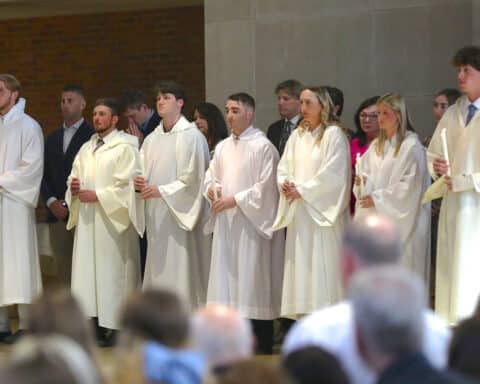Scripture seldom has an angel begin a visit with “Hello.” There’s no “How are you?”
Yes, to a young woman in Nazareth it’s, “Hail, favored one! The Lord is with you.” Then, seeing her reaction: “Do not be afraid, Mary.”
Time and time again, it’s “Fear not,” “Do not be afraid” or some variation on that theme.
Perhaps in Aramaic, Hebrew or another ancient language used by the people of Old and New Testament times, those were the equivalent to our own “Hey, it’s OK.” Or “Yeah, I know, but just be cool.”
“Fear not” is asking a lot of anyone under those circumstances.
Then the angel delivers the particular message and, because we know the end of the story, everything seems to be relatively fine. A little bumpy at times, certainly, but — spoiler alert — God takes care of him or her, and it all works out in the end.
Accepting God’s call
Maybe it would be more comforting for us, even perhaps easier to believe, if just one of the recipients of those messages, with eyes cast upward, had said, “Are you kidding me, God?!” Because, let’s be honest now, isn’t that how you feel?
Isn’t that what you want to ask when it seems pretty clear God has revealed a bit of his plan for you?
Exclusively for you. This path. This challenge. This calling – right here, right now.
And you’re … afraid.
Hopeful. (Perhaps God misdialed.)
Dumbfounded. (“I thought you really knew me, God, but I can tell from this that…”)
And humbled. (Really? Me? Wow!)
But, again, let’s be honest: Mostly, you’re terrified.
Just as, it seems likely, so was every character in the Bible who was visited by an angel and told to “fear not.” Every character who did what God asked him or her to do. Every character who not only had the God-given gift of faith but then used that gift, no matter how frightened or unsure he or she was. Not just with the angel’s appearance and message, but also at some points along the way of the path on which God had set his chosen one. (Mary was frightened later? Well, it seems safe to speculate her blood pressure was up during the three days she and Joseph searched for Jesus before finding him in the Temple.)
Facing fears
A few points to keep in mind.
1. Faith and fear aren’t mutually exclusive. Imagine a stained-glass window with a Venn diagram (you know, one circle intersecting another). The first is blue: faith. The second is red: fear. The middle, the intersecting part, is purple. There can be a lot of purple. A great jumble of faith and fear (in a penitential color, which seems pretty darned appropriate).
2. Fear is easy. We can do it when we’re an infant. We can do it when we’re 100-plus. We can and do fear at every step and stage in between. Faith takes two things: God and you. To quote the glossary from the Catechism of the Catholic Church, it’s “both a gift from God and a human act by which the believer gives personal adherence to God who invites his response.”
3. What about “fear of the Lord”? Again to quote the glossary, it’s “one of the seven gifts of the Holy Spirit that ensures our awe and reverence before God.” We aren’t God’s peers. We owe him everything. But, to quote St. Gregory, “We do not render true service to God so long as we obey from fear and not from love.” Maturely acting on faith isn’t based on our concern for God smiting us; its foundation is our love for the God who loved us first. And always will. Perhaps a way of looking at it in human terms is this: We don’t want to let him down.
| Faith and Fear |
|---|
On moving mountainsScripture verse: “Then the disciples approached Jesus in private and said, ‘Why could we not drive it [a demon] out?’ He said to them, ‘Because of your little faith. Amen, I say to you, if you have faith the size of a mustard seed, you will say to this mountain, “Move from here to there,” and it will move. Nothing will be impossible for you'” (Mt 17:19-20).
Commentary: “The disciples have a faith of understanding and assent but not of sufficient trust. … The whole episode thus becomes an instruction to the disciples on the power of trusting faith” (The New Jerome Biblical Commentary).
On faith versus worksScripture verse: “What good is it, my brothers, if someone says he has faith but does not have works? Can that faith save him? If a brother or sister has nothing to wear and has no food for the day, and one of you says to them, ‘Go in peace, keep warm and eat well,’ but you do not give them the necessities of the body, what good is it? So also faith of itself, if it does not have works, is dead. Indeed someone may say, ‘You have faith and I have works.’ Demonstrate your faith to me without works, and I will demonstrate my faith to you from my works” (Jas 2:14-18).
Commentary: “James does not here imply the possibility of true faith existing apart from deeds, but merely of the making of such a claim. … James means by faith the free acceptance of God’s saving revelation. … By ‘works’ is meant the obedient implementation of God’s revealed will in every aspect of life. … Note that James is not opposing faith and works, but living faith with dead faith” (The New Jerome Biblical Commentary).
|
4. Faith builds on faith. Fear builds on fear. Yes, we can “conquer” our fears, but — surprise! — there will be new ones popping up just around the corner. In a similar way, we can act on faith and, through the grace of God, accomplish things we never thought possible. But again — surprise! — there will be more God-given invitations to do something new. Challenging. Seemingly impossible. Or to be more blunt, stuff that just seems crazy. How can God possibly think I can?
5. You’re in good company if you’re afraid despite having quite a bit of faith and using it wisely. Consider the apostles: “Come follow me.” And they did. They stepped away from the lives they were living and went with Jesus. They were taught by him for three years, witnessed miracles and came to believe he was the Messiah. He was — is! — the Son of God. And yet, they scattered like chickens when Our Lord was arrested on the evening of Holy Thursday. And except for John, they were nowhere to be seen on Good Friday. (Actually, Peter was around early that morning, but he repeatedly claimed, “I don’t know the man.”) Faith and fear. On that day, for all but John, fear won.
6. What about after Jesus ascended and he and the Father sent the Holy Spirit? What about after Pentecost? Very good questions. Then the Twelve (11 originals and one new fellow to replace Judas) had faith that steamrolled over fear. We know from Scripture that some were executed. And from Tradition that all but John died that way.
7. “We must not fear challenges.” Earlier this year during his one-day visit to Milan, Pope Francis made some off-the-cuff remarks on faith and fear to priests and consecrated persons. He told them: “We must not fear challenges. How often do we hear lamentations: ‘Ah, these days, there are so many challenges, and we are sad. …’ No. Do not be afraid. We must instead fear a faith without challenges, a faith that considers itself complete, all complete: it does not need other things, all is done. This faith is so watered down that it is useless. We must be afraid of this.”
8. One final point. God’s not afraid you’ll mess things up. He always has faith in you.





